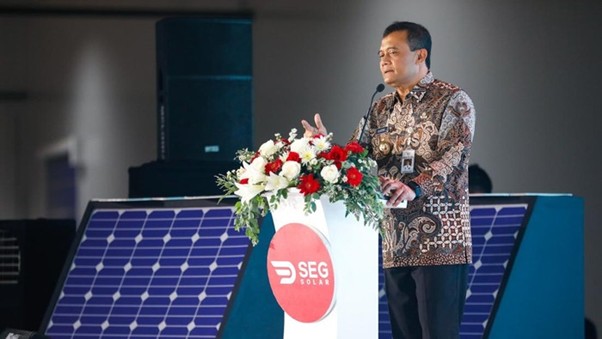PUSHING RENEWABLE ENERGY: CENTRAL JAVA BUILDS RP7,6 – 8 TRILLION SOLAR PANEL FACTORY

(Source: detik.com)
Why Renewable Energy is Key to Indonesia’s Future
Indonesia, the world’s fourth most populous country, faces a critical energy challenge. For decades, the nation has relied heavily on fossil fuels—particularly coal and oil—to drive its economy. But as global concerns about climate change intensify, and as domestic demand for cleaner, more sustainable power sources grows, Indonesia has no choice but to accelerate its renewable energy transition.
Renewable energy, especially solar, represents both an opportunity and a necessity. The country is blessed with abundant sunlight, making solar power one of the most promising energy sources to support long-term sustainability. Beyond environmental benefits, renewable energy offers strategic value: reducing dependence on costly fuel imports, boosting energy security, and strengthening the economy through new industries.
Against this backdrop, Central Java has emerged as a pioneer in renewable energy development. Its latest milestone is the construction of a $500 million (approximately Rp7.6–8 trillion) solar panel manufacturing facility in Batang. This investment is not only a financial breakthrough but also a symbol of Indonesia’s growing commitment to energy independence.
Central Java’s Commitment to Green Industry
Central Java, under the leadership of Governor Ahmad Luthfi, has positioned itself as a hub for green and sustainable industries. The provincial government has consistently emphasized the importance of renewable energy, both to attract foreign investment and to align with Indonesia’s national renewable energy targets.
In recent years, foreign investors have shown growing interest in Central Java precisely because of its renewable energy policies. Governor Luthfi himself noted that when potential investors inquire about opportunities in the region, renewable energy projects are always among their first questions. This reflects a global shift: sustainability is no longer a niche consideration but a decisive factor in global business strategy.
The establishment of a state-of-the-art solar panel factory in Batang is more than just an industrial development—it is a statement of intent. Central Java is signaling to the world that it is ready to be at the forefront of Southeast Asia’s green economy.
The Landmark Solar Panel Investment in Batang. Investment Scale and Global Collaboration
The newly inaugurated facility in Batang is a project by PT SEG Solar Manufacturing Indonesia, a subsidiary of SEG Solar, a major U.S.-based renewable energy company. With an investment value of around USD 500 million, this project marks one of the most significant foreign direct investments in Indonesia’s renewable energy sector.
This collaboration not only strengthens ties between Indonesia and the United States but also sets a precedent for future international partnerships in clean energy. In an era where global supply chains are being restructured around sustainability, such investments highlight Indonesia’s potential as a central player in renewable energy manufacturing.
PT SEG Solar Manufacturing Indonesia’s Role
PT SEG Solar Manufacturing Indonesia is spearheading this project with the ambition of making Batang home to the largest integrated solar panel factory in Southeast Asia. The company’s presence is expected to significantly accelerate Indonesia’s adoption of renewable energy technologies, while also introducing cutting-edge innovation into the country’s industrial ecosystem.
For Indonesia, partnering with an established global player like SEG Solar provides not just capital, but also access to advanced technology, global market networks, and expertise in managing large-scale renewable energy projects. This transfer of knowledge will be crucial for nurturing local industries and talent in the long term.
Capacity and Technological Significance A 5 GW Solar Cell and Module Production Hub
One of the most striking aspects of the Batang facility is its production capacity. Once fully operational, the factory will produce up to 5 gigawatts (GW) of solar cells and 5 GW of solar modules annually. To put that into perspective, this capacity is enough to power millions of households or to contribute significantly toward Indonesia’s renewable energy generation targets.
The sheer scale of this facility positions it as a regional leader in photovoltaic (PV) manufacturing. With solar demand rising not just domestically but also across Asia and beyond, the Batang plant has the potential to become a major export hub, strengthening Indonesia’s role in the global renewable energy supply chain.
The Largest Integrated PV Factory in Southeast Asia
Beyond its scale, the Batang plant’s integrated model makes it particularly noteworthy. Unlike smaller factories that only handle one part of the process, this facility integrates multiple stages of solar manufacturing, from raw material processing to finished panels. This approach not only improves efficiency but also enhances quality control, making the factory highly competitive in global markets.
By becoming Southeast Asia’s largest integrated PV facility, Central Java is sending a clear signal: Indonesia is no longer just a consumer of renewable technologies—it is becoming a producer and innovator in its own right.
Job Creation and Workforce Development
The Batang solar factory is expected to create thousands of jobs for Indonesians. In its initial phase, the facility has already employed 350 local workers alongside 70 foreign experts. Over time, it is projected to generate more than 3,000 jobs, ranging from skilled technical positions to managerial roles.
This is not just about employment numbers—it is also about workforce development. By collaborating with international partners, Indonesian workers will gain exposure to advanced technologies, management systems, and global best practices in renewable energy manufacturing. This knowledge transfer will help build a stronger domestic workforce capable of sustaining the industry in the long run.
Boosting Local and National Economies
On a macroeconomic level, the solar factory represents a significant boost to both Central Java’s and Indonesia’s economies. The inflow of foreign direct investment strengthens the country’s industrial base, diversifies its economic portfolio, and enhances its competitiveness in international markets.
For local communities in Batang, the project also brings tangible benefits—improved infrastructure, new business opportunities, and a stronger local economy. Suppliers, contractors, and small businesses in the region stand to benefit from the increased economic activity generated by the factory.
Why Global Investors Prioritize Renewable Projects
One of the most remarkable aspects of the Batang solar investment is how it reflects global investor sentiment. Across the world, renewable energy projects are increasingly seen as not only profitable but also strategically essential. Investors recognize that the global transition toward sustainability is inevitable, and positioning themselves in this sector ensures long-term relevance.
Governor Ahmad Luthfi highlighted that foreign investors consistently inquire about renewable energy opportunities in Central Java. This underscores how sustainability is now a decisive criterion in investment decisions. For regions like Central Java, this trend represents an opportunity to attract high-value investments while simultaneously advancing environmental and social goals.
Central Java as a Gateway for Green Investment
By establishing itself as a renewable energy hub, Central Java is carving out a unique identity within Indonesia and Southeast Asia. The Batang project is more than a single factory—it is a gateway for further green investments. With the success of this initiative, other international players are likely to follow, seeking to capitalize on Central Java’s strategic location, skilled workforce, and supportive policy environment.
As renewable energy becomes a global priority, Central Java is well-positioned to leverage its pioneering role to attract continued investment, foster innovation, and build a sustainable economic future.
References:
- DetikJateng. (2025). Resmikan Pabrik Panel Surya, Ahmad Luthfi: Investasi Luar Selalu Tanya EBT. Retrieved from https://www.detik.com/jateng/jawa-tengah-meriah/d-8051468/resmikan-pabrik-panel-surya-ahmad-luthfi-investasi-luar-selalu-tanya-ebt
- DetikJateng. (2025). Ahmad Luthfi Pastikan Industri Hijau di Jateng Terus Tumbuh. Retrieved from https://www.detik.com/jateng/berita/d-8051354/ahmad-luthfi-pastikan-industri-hijau-di-jateng-terus-tumbuh
- DetikFinance. (2024). Pabrik Solar Panel Asal AS Beroperasi di Batang April. Retrieved from https://finance.detik.com/industri/d-7809542/pabrik-solar-panel-asal-as-beroperasi-di-batang-april
- DetikFinance. (2024). Perusahaan Raksasa Panel Surya Asal AS Resmi Bangun Pabrik Rp7,6 T. Retrieved from https://finance.detik.com/industri/d-7566980/perusahaan-raksasa-panel-surya-asal-as-resmi-bangun-pabrik-rp-7-6-t




Comments :